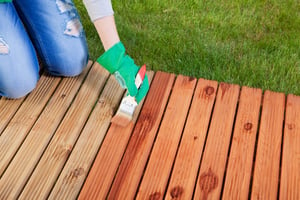 Keeping your deck looking nice is a tough job. Mother Nature throws a lot of different weather elements at it. As an owner of a cedar deck, I’ve spent plenty of hours trying to keep it looking its best. If summer has been simply too hot or you’ve been putting it off, now may be the time to start thinking about it.
Keeping your deck looking nice is a tough job. Mother Nature throws a lot of different weather elements at it. As an owner of a cedar deck, I’ve spent plenty of hours trying to keep it looking its best. If summer has been simply too hot or you’ve been putting it off, now may be the time to start thinking about it.
Here are some tips to help you with your project.
Stain vs. paint
No matter what type of deck you have, finishing it with stain or paint will protect it from the weather, and increase its lifespan. So, if you’re wondering what the difference is between the two, here we go!
Stain
- If your deck is brand new, a transparent stain is a good choice. This allows you to enjoy the wood’s natural beauty.
- Stain is usually cheaper per gallon.
- Staining doesn’t require the use of primer and it’s easier to apply.
- Stain does require more regular maintenance.
- Stain works well on newer decks.
Paint
- Paint offers a wider variety of color choices and allows for more creativity.
- Paint lasts longer.
- Paint allows for easier surface cleaning.
- As a deck ages, this becomes a nice option to hide some of the imperfections in the wood.
Sandpaper types
Whether you’re sanding your deck or working on another project, understanding sandpaper grit can help you be more efficient, and provide you with a nice finished product.
- Extra course sandpaper (34 – 36 grit) can be used for difficult jobs where paint and varnish need to be removed.
- Course sandpaper (40 – 50 grit) may also be used for removing finishes, as well as polyurethane.
- Medium sandpaper (60 – 100 grit) can be used for sanding rough wood.
- Fine sandpaper (120 – 220 grit) can be used for work that’s near completion to create the finishing touch.
- Extra fine sandpaper (240, 320, 400 grit) can be used to remove small blemishes or inconsistencies from a finish that has been applied. It won’t remove the finish like a course sandpaper would.
Preparation steps
Before applying your stain or paint it’s important to make sure your deck is properly prepared.
1. Remove debris. Decaying leaves, bird droppings, and berries that have fallen off your trees can make a real mess on your deck. Make sure you give it a good sweep or use a blower.
2. Apply a cleanser. To remove any tough remaining stains thoroughly apply a cleanser. Let it soak for the manufacturer’s recommended time period and then thoroughly scrub it with a stiff bristle brush. When you’re finished, rinse the cleanser from the wood using a garden hose or pressure washer. If you use a pressure washer, be cautious. A high-powered pressure washer can damage the wood. Allow 48 hours for the wood to dry.
3. Apply a stain/paint remover. For the best results, removing the remaining paint or stain is key. However, this process can be very time consuming. To see what options you have, I recommend talking to your local hardware or paint store. Some paints may allow you to go over the old stain/paint without spending a lot of time stripping the wood.
4. Inspect the boards. Before painting or staining it’s important to look for loose nails and screws, as well as imperfections in the wood. If you find loose nails or screws, remove them, and insert new ones. If nail or screw heads are not flush with the boards also consider removing them and inserting new ones. This can help prevent injury.
If you notice large cracks, consider filling them with an epoxy putty. The epoxy can be applied easily with a putty knife. Make sure to let it dry thoroughly before sanding or painting. Don’t forget to fill nail holes or rotted wood with putty as well.
5. Sand-ridged, rough, or uneven surfaces. Based on your job, refer to the sandpaper types above to effectively carry out this step. Make sure to remove excess dust when you’re finished.
6. Take a little extra time. Using painters’ tape, take some time to properly cover up surfaces that you don’t want painted or stained. This would include your home’s siding, aluminum spindles, and around doors. If you have plants around your deck, consider using a drop cloth or plastic to protect them. However, don’t leave the coverings on for extended periods of time.
7. Caulk the joints. If you have wood joints that don’t come together like they used to, consider using caulk to fill in the space. On my deck, I notice this happening particularly around the posts.
8. Apply paint or stain. Follow the manufacturer’s directions for application. It’s important to monitor temperature and potential precipitation.
As I mentioned, keeping your deck looking good is a tough job. However, the enjoyment and relaxation it can provide is worth it!
Do you have any tips or information you’d like to share? I’d love to hear from you. Please share them in the box below.
Source
https://www.bobvila.com/articles/painting-vs-staining-a-deck/
https://www.bobvila.com/articles/2145-quick-tip-choosing-sandpaper/





